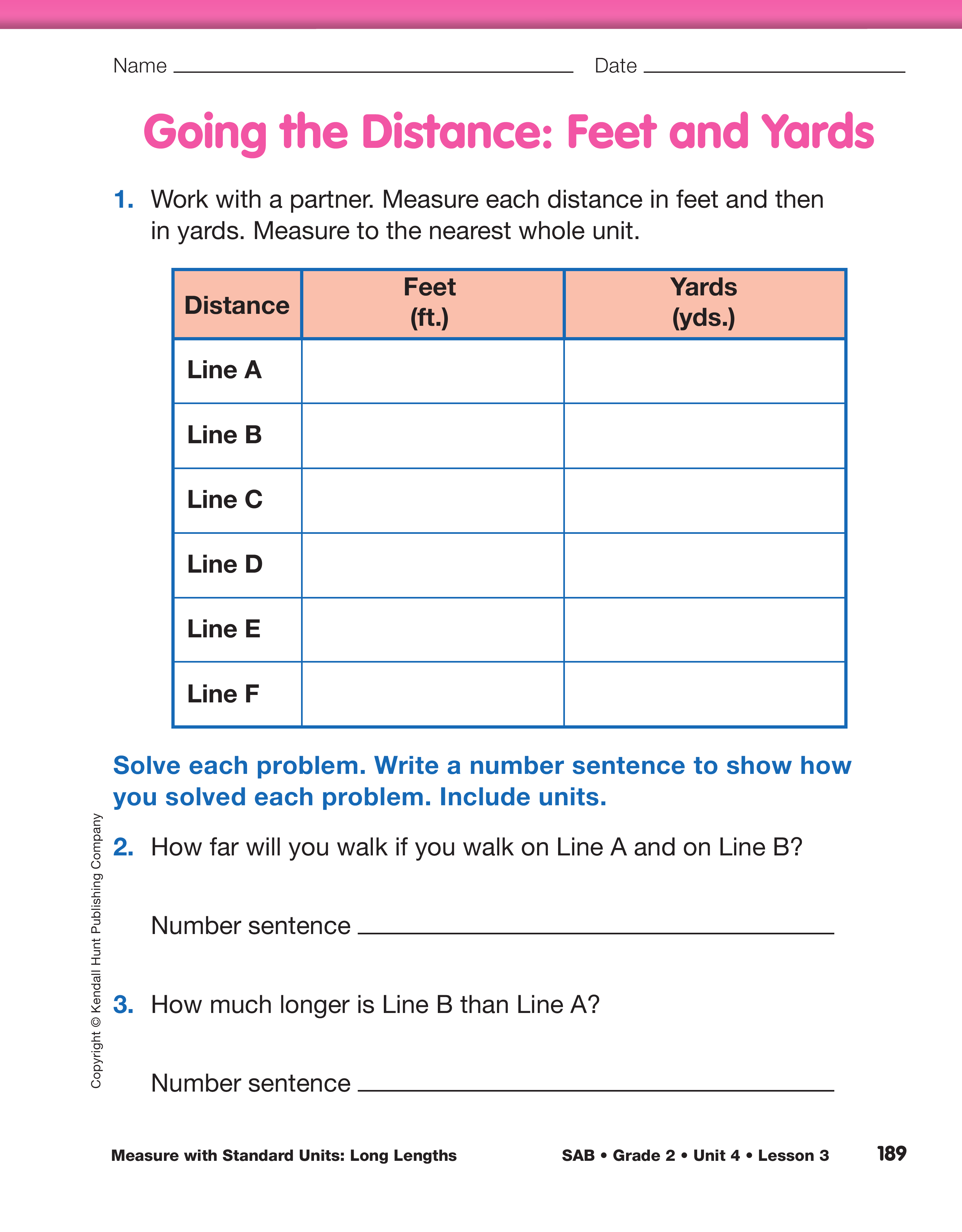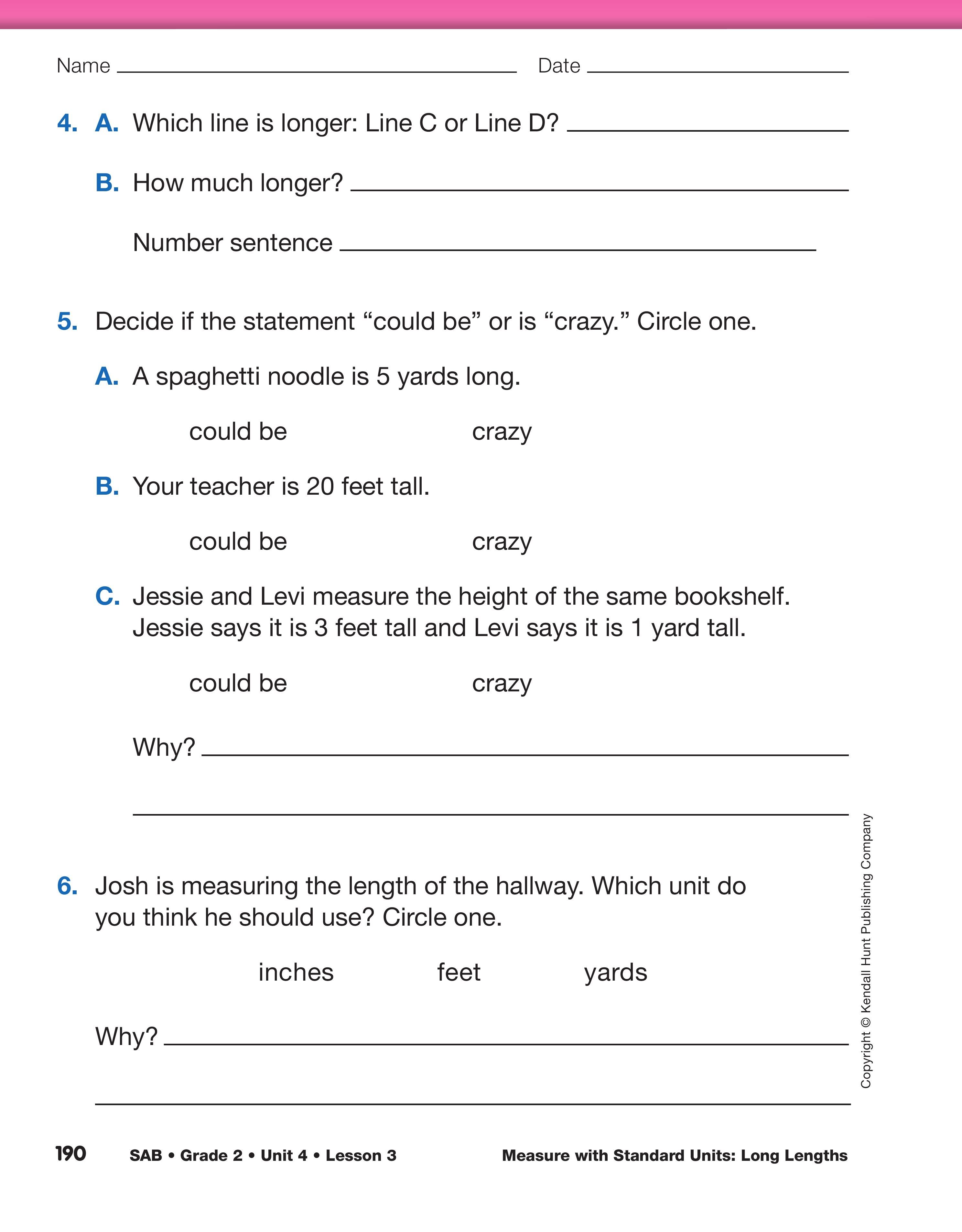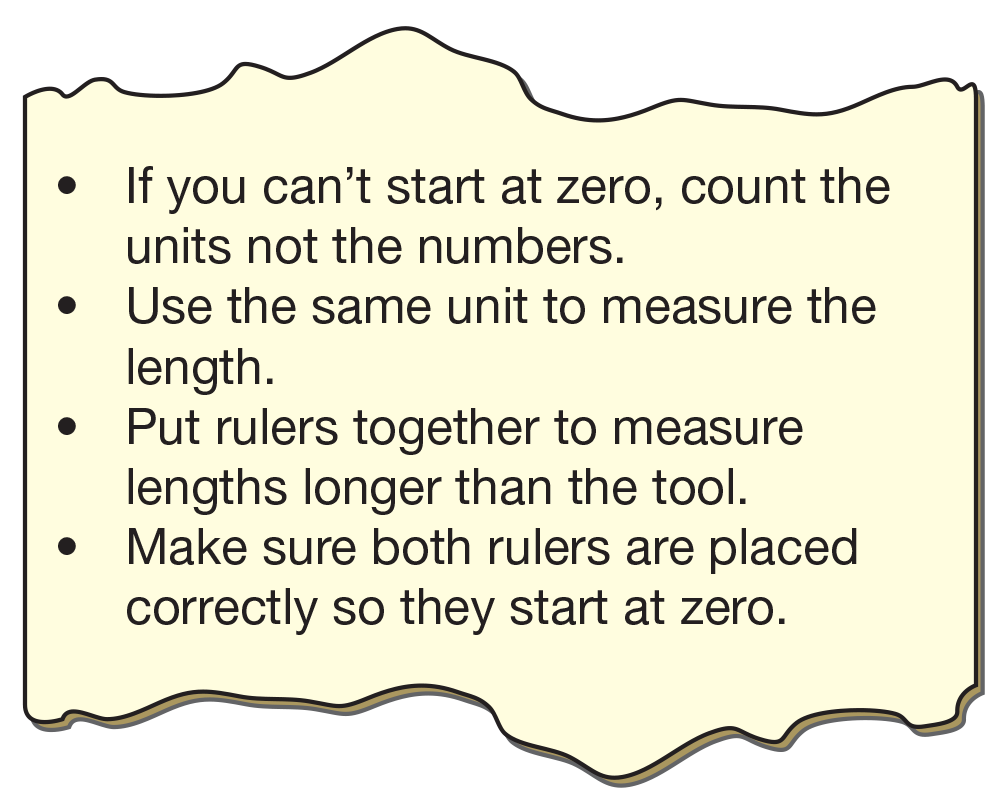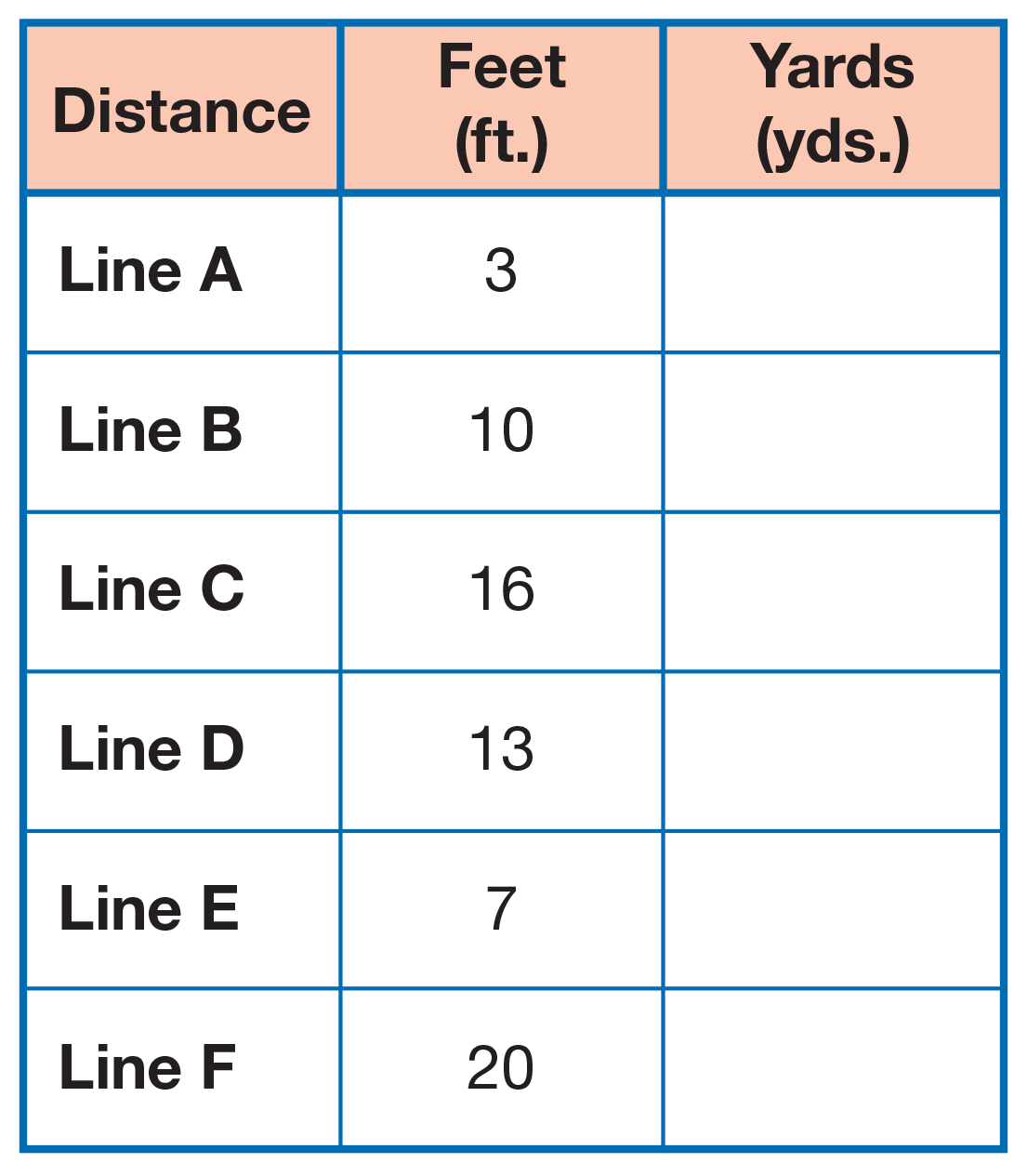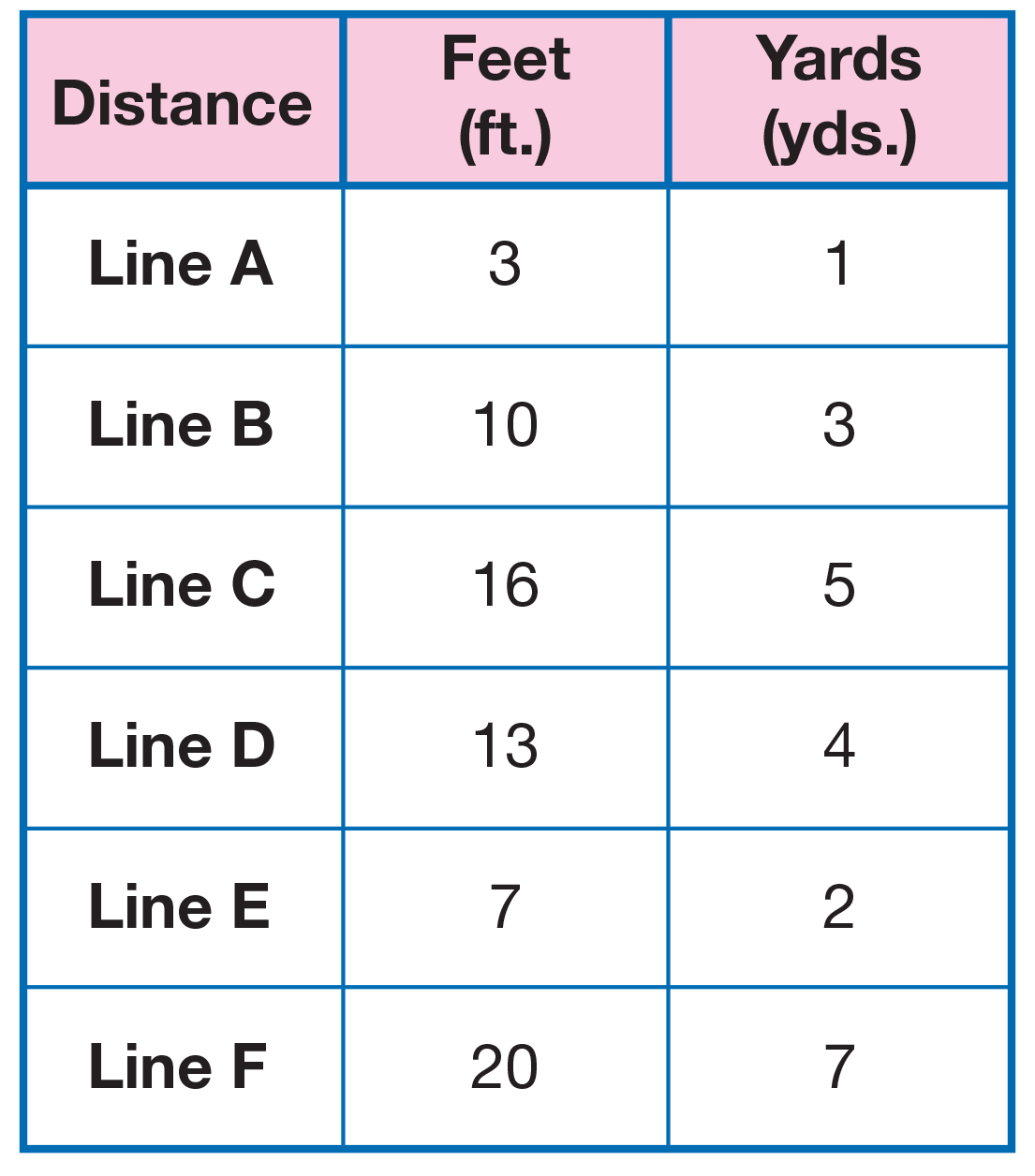Measure in Feet. Show students the 5-meter line
you prepared, Line C. Remind students that they
measured the length of this line in footprints in
Lesson 1.
- How many footprints long is this line?
- How many Apatosaurus footprints is the length of
the line? Do you think it will be more or less than
the number of children's footprints? Why? (less;
Apatosaurus footprints are larger, so we will need
less of them to measure the line.)
Ask a student to measure the line with their footprints
and then use the Apatosaurus footprint from
Lesson 1 to measure the length of the line.
- How many footprints long is the line? (Possible
response: It depends on the unit size. Line C is
about 25 student footprints but about
5 Apatosaurus footprints.)
- Do you think there is a standard unit for a foot? (Possible response: Yes, I have heard about feet.
Sometimes my height is measured in feet.)
Show students the 12-inch ruler. Tell students that
the ruler, or 12 inches, is 1 foot.
- Is your footprint longer or shorter than 1 foot? (Possible response: shorter)
- Is one foot longer or shorter than Line C? (shorter)
- How could you use the ruler to measure the line? (Possible response: Use two rulers like we did
with our footprints and palms.)
Ask two students to demonstrate how to measure the
length of Line C using two 12-inch, or 1-foot, rulers.
When they near the end of the line, ask:
- Did you reach the end of the line?
- Is the line closer to 16 feet or 17 feet?
- How did you decide?
- What advice from the Measurement Advice chart
did you use? (Possible responses: Keep the units
in a line, without gaps or overlaps; count the
units starting from the end of the line and stop
when you get to the other end.)
Display the table on the Going the Distance: Feet
and Yards pages from the Student Activity Book.
Show students the six lines you prepared and how
the labels correspond to the lines listed in the table.
Tell students they will work with a partner to measure
2 of these lines in feet. They should measure to
the nearest whole unit. Provide each student with a
12-inch (or 1-foot) ruler and assign each pair a set of
lines to measure. Ask students to record their measurements
in the table in Question 1. See Figure 3.
Ask some students to share their measurements by
recording them on the display of the table. Ask:
- I see [student name] measured [Line A] to be
[3 feet]. Who else measured [Line A]?
- Did you get the same measurement for [Line A]?
- How did you decide if the line was closer to [3 feet]
or [4 feet]? (Possible response: 4 feet is way too
much. The line is just a little longer than 3 feet,
not a lot longer.)
- Did everyone who measured [Line D] get the same
measurement? (Possible response: All the measurements
should be about the same since the
units are all the same size. The only reason they
will be different is if we estimate the "leftover"
differently.) [See Content Note.]
Once the display table is complete, ask students to
record the measurements they are missing on their
copy of the table on the Going the Distance: Feet
and Yards page.
Students need experience with units before they can estimate
and reason about the size of a unit. Focus students' attention
on the size of the 1-foot ruler rather than the 12 inches on
the foot ruler.
Whether a student should round up or round down to the
nearest whole unit is dependent on the situation. Since
students are measuring for less-than-authentic reasons, they
can decide to round up to the next whole unit or down to the
previous whole unit. Some students may start to express a
measurement as parts of a unit (e.g., 312 feet). Students
should be encouraged to express and justify their more
accurate measurements but then record their measurements
as whole units so comparisons can be made easily.
Measure in Yards. Display a yardstick and tell students
that the unit is called a yard.
- You are going to measure the same lines with this
unit. Is the number in your measurement going to
be larger or smaller than your measurement in
feet? (smaller)
- Why? (Possible response: The unit is larger.)
- Is [Line C] longer or shorter than the unit I am
showing you? (Possible response: The line is
longer.)
- How are you going to measure [Line C] with this
unit? (Possible response: Work with a partner and
"leap frog" one unit over the other.)
If students will be using modified metersticks as yardsticks,
be sure to show them how to line up the units so there are no
gaps. See Figure 4.
Ask students to choose two lines to measure to the
nearest yard. Each student group will need two yardsticks.
Students should record their measurements on
the table in the Going the Distance: Feet and Yards
page. See Figure 5.
As students are working, circulate
and ask:
- Did you reach the end of the line?
- Is the line closer to [5 yards] or [4 yards]?
- How did you decide?
- What advice from the Measurement Advice chart
did you use? (Possible response: Keep the units
in a line without gaps or overlaps; count the units
starting from the end of the line and stop when
you get to the other end.)
Ask some students to share their measurements by
recording them on the display of the table.
After the
table is complete, ask:
- I see [student name] measured [Line D] to be
[4 yards]. Who else measured [Line D]?
- Did you get the same measurement for [Line D]?
- How did you decide if the line was closer to
[4 yards] or [5 yards]? (Possible response: 5 yards
was too much. The line is closer to 4 yards.)
- Did everyone that measured [Line D] get the same
measurement? (Possible response: All the measurements
should be about the same since the
units are all the same size. The only reason they
will be different is if we estimate the "leftover"
differently.)
Once the display table is complete, ask students to
record the measurements they are missing on their
copy of the table on the Going the Distance: Feet
and Yards page.
Instruct students to complete Questions 2–6 on the
Going the Distance: Feet and Yards page.
- Show how you solved Question [2].
- I think that Line A and B together will be 6 feet. Do
you think I am correct? Why or why not? (No;
Line A is 3 feet and Line B is 10 feet, so together
they are 13 feet.)
- What advice would you give me? (Possible
response: You added feet and yards and that's not
correct. The units have to be the same when
putting the lengths together.)
- Does it take more feet or more yards to measure a
line? Why? (feet because the unit is smaller)
- Did you like using feet or yards better when you
measured these lines? Why? (Possible responses:
I like yards because they are larger and the measurement
is faster; I like feet because I don't have
to deal with parts of a unit as much.)
- Which unit do you think you would use to measure
the width of your desk? (Possible response: I
would use inches, feet, or centimeters.)
- Why? (Possible response: Yards are too big.)
Discuss the statements in Questions 5–6.
- Why is this statement "crazy"?
- Why is this statement a "could be"?
- How can you change the statement so it "could
be"?
- How can both Levi and Jessie be correct? (3 feet
and 1 yard are the same distance. They just measured
the distance in different units.)
- What unit do you think Josh should use in
Question 6? Why? (Possible response: feet or
yards; inches are small and would take a lot of
time to count. Yards or feet are larger so there are
not so many to count.)















